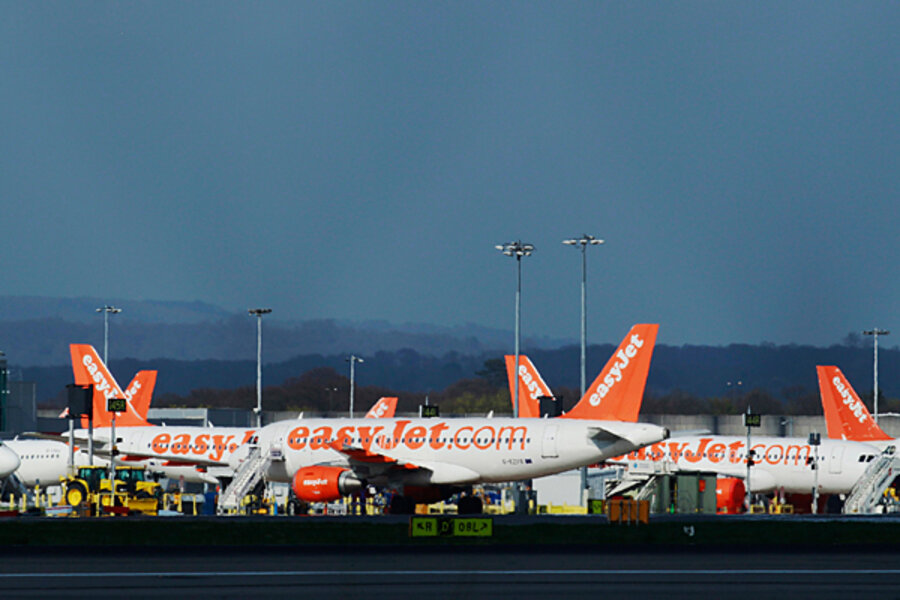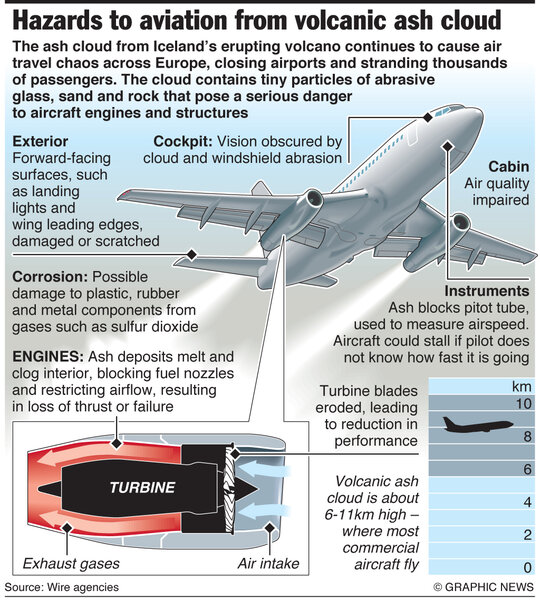Why can't jets fly in volcanic ash clouds?
| Boston
Commercial jets fly through clouds all the time. Why can't they fly in volcanic ash clouds?
The short answer is that volcanic ash is made up of tiny pieces of glass that can shut down a jet engine.
A jet engine sucks in huge amounts of air that mixes with the fuel, ignites, and releases energy.
When these bits of volcanic glass get drawn into a gas turbine jet engine, they melt and fuse to parts of the engine. The melting point of volcanic ash is about 1,100 Celsius. But a jet engine operates at temperatures about 300 degrees hotter. The bits of glass tend to melt onto the fuel nozzles and turbine blades, rather than simply passing through the engine.
The result: the jet engine (or engines) may quit.
The volcanic ash tends to be concentrated at the high altitudes where commercial airliners fly. But near the ground, it's dispersed, and doesn't have the same effect on cars, trains, or ship engines.
Boeing, one of the world's largest manufacturers of commercial aircraft, says there have been about 90 incidents of aircraft being damaged by volcanic ash over the past three decades. One of the worst was the case of British Airways Flight 9 from London to Auckland, New Zealand. On June 24, 1982, the Boeing 747-200 flew through volcanic ash spewing from Mount Galunggung in Indonesia. All four jet engines quit within one minute. The plane dropped from 36,000 feet to 13,000 feet before the crew was able to restart each of the engines.
Pilots have found that jet engines can often be restarted once the aircraft drops to a lower altitude, as the glass on the engine parts hardens, shatters, and falls away.
The British Airways Flight 9 crew landed the aircraft safely in Jarkarta, Indonesia, but the volcanic ash had sandblasted the windshield of the aircraft, making it almost impossible for the pilots to see the runway. Watch a short Al Jazeera video (at the end of this blog) that includes a brief interview with the now-retired British Airways Capt. Eric Moody who describes piloting of that flight.
Volcanic ash doesn't tend to show up on aircraft weather radar (and it didn't during that British Airways Flight 9), because the radar is designed to detect moisture (thunder clouds) and the ash is too dry - or the particles are too small - to register. Also, the volcanic ash is often not visible at night.
To help aircraft avoid volcanic ash, Volcanic Ash Advisory Centers (VAAC) were set up in the 1990s. The VAACs cover nine regions around the globe. The two that airlines rely on in Europe are in London and Paris, and are part of the national weather services in their respective countries.
The VAAC in the Met Office in Britain is tracking the volcanic ash coming from Iceland, and its site includes updates and a map or chart of the ash in the area. The maps are updated every six hours. The VAAC web sites advise airline passengers to check the airline websites. British Airways, for example, has a section on flights canceled by the volcanic ash.






